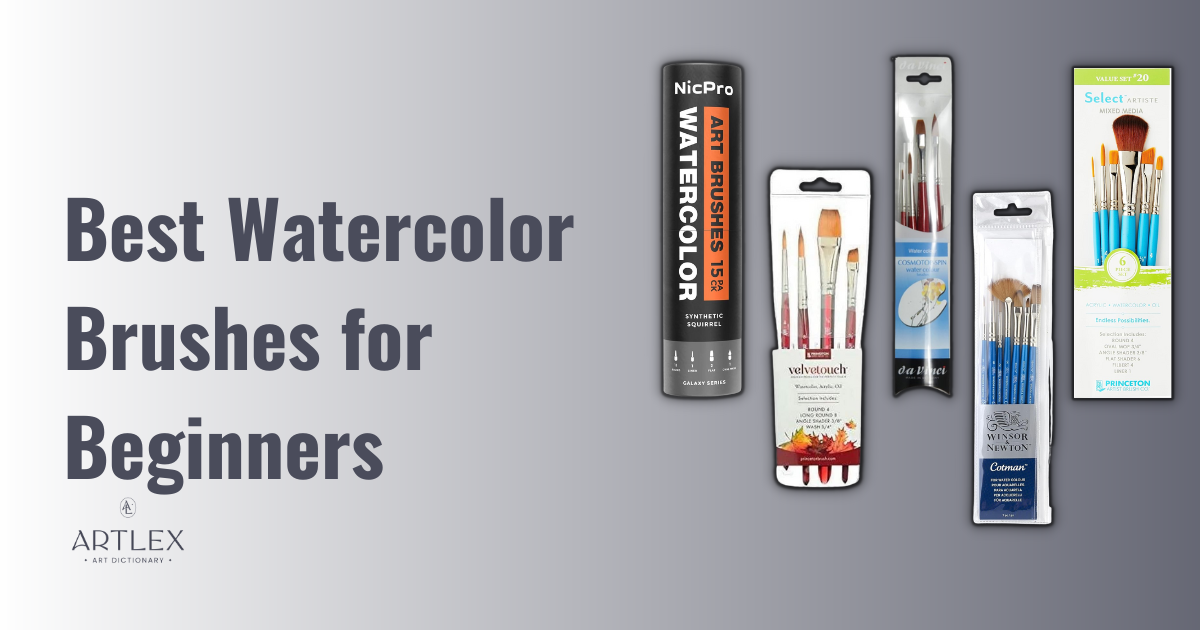 When I started my watercolor journey back then, I did it with off-brand watercolor tubes and the cheapest brushes from the dollar store. Thinking about it now, it’s kind of sad, but as an absolute beginner (and a kid at that), I didn’t know any better. And guess what? This is the case for many who are just starting out.
When I started my watercolor journey back then, I did it with off-brand watercolor tubes and the cheapest brushes from the dollar store. Thinking about it now, it’s kind of sad, but as an absolute beginner (and a kid at that), I didn’t know any better. And guess what? This is the case for many who are just starting out.
If you’re in the same boat (armed with enthusiasm but drowning in a sea of choices and with a limited budget) don’t worry, you’re not alone.
Whether you’re at a local art supply store or scrolling through an endless list of online products, picking the right brushes can feel like an art form itself. Round, flat, natural, synthetic, it’s all just too much.
But here’s the good news: You don’t have to go through it alone. 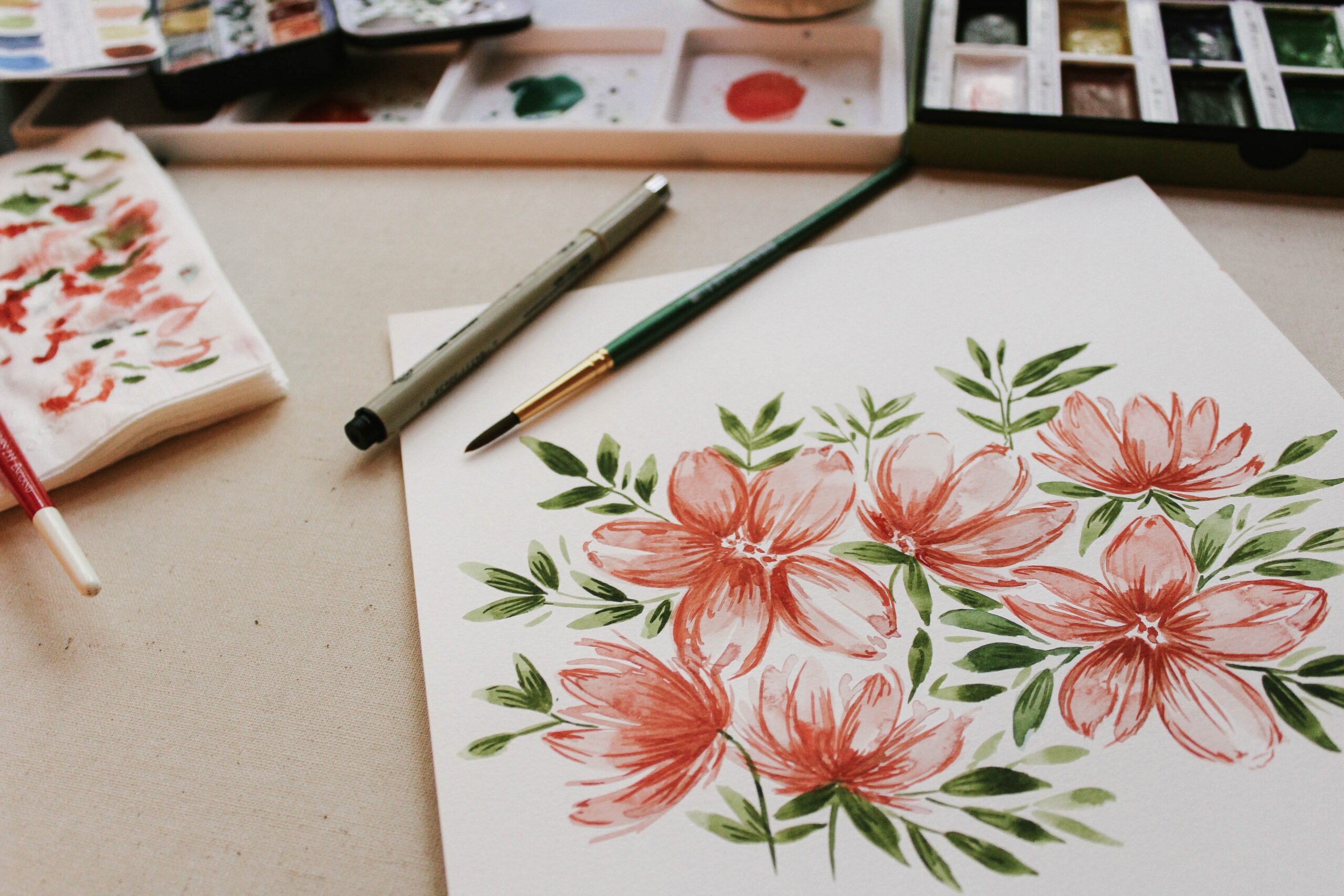
Over the years, I’ve learned a thing or two about what makes a good brush for watercolor painting, and I have a few recommendations, especially for beginners. In this article, we’re not only going to go over the brushes and brands you can use, but also we’re going to learn how to use said brushes, what are they made of, and what they are good for plus a few tips and tricks for painting with watercolors.
Let’s get started!
Watercolor Brushes 101: What You Need to Know
A paintbrush, be it for watercolors, acrylics, or oil paints shares a similar anatomy, which may lead to confusion for those who don’t know much about brushes (I remember getting long-handle detail brushes for oil paints for my first gouache class, what a mess) and even though some brushes can be used with different mediums, some are exclusive to a single medium or made for certain uses.
We can learn to differentiate them by looking at them. Let’s learn about their anatomy: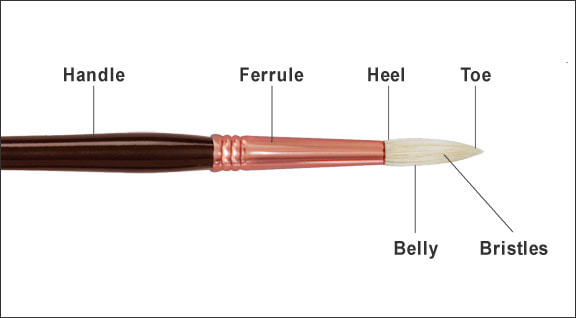
The Head
First, we have the head, the most important part of the brush, and the one we should look at when buying brushes the most. The head is where the bristles are and it’s formed by the tip, the belly, and the heel.
What characterizes watercolor brushes the most is the material they are made of. Since watercolor brushes are designed to hold a lot of water, they are usually made from the softest natural hairs like sable (or squirrel) or synthetic materials that mimic that softness.
Unlike brushes for acrylics or oils, watercolor brushes typically feature much softer bristles, which is crucial to avoid damaging watercolor paper and to achieve the delicate washes and blends that watercolors are famous for.
By looking at the head we can also find out what the brush is good for. Different shapes mean different uses as well and different sizes are meant for certain techniques. Here’s a quick overview of the most common watercolor brush types:
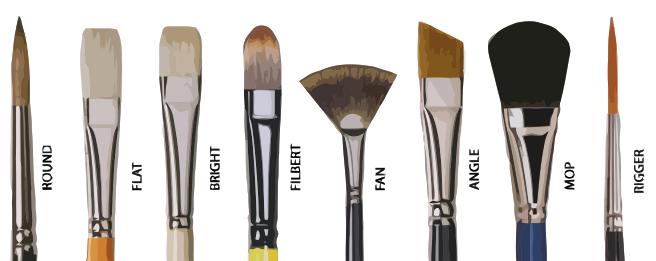
- Round Brushes: Great for all-purpose painting. You can make tiny details or broader strokes. It’s versatile, so if you’re buying your first brush, this is a good one to start with.
- Flat Brushes: These are your go-to brushes for bold, straight lines, or for covering large spaces fast. Think of them as your “wide coverage” tool.
- Filbert Brushes: Imagine a mix of round and flat brushes. You can use these for blending colors softly or making brush strokes that have a rounded edge.
- Mop Brushes: These are like sponges; they can soak up a lot of water. Use them when you want to spread a lot of color over a large area quickly.
- Wash Brushes: Similar to mop brushes but a bit flatter and wider. These are good for when you want to cover your paper with a single color quickly.
- Fan Brushes: These are specialty brushes you might not use every day. They’re great for creating texture, like leaves on trees or ripples in water.
- Detail Brushes: These are your tiny brushes for really small details. Use them for highlights, deep shadows, and for adding weight to lines.
- Rigger Brushes: Long and thin, these are for super-fine lines. They’re perfect for adding intricate details like branches or hair.
- Dagger/Sword Brushes: These have a unique shape that tapers to a fine point. They’re good for sweeping lines and details that require varied line thickness in one stroke.
- Sumi Brushes: Traditional Asian brushes for free-flowing lines. Great for calligraphy or expressive, gestural strokes.
The Ferrule
The Ferrule is the metallic band that holds the bristles together, don’t underestimate this component; it’s more important than it may seem at first glance.
Ferrules are commonly made of nickel-plated brass, aluminum, or plastic. Nickel-plated brass tends to be more durable and less prone to rust.
A good ferrule won’t wobble or come loose, ensuring your bristles stay in place, if the ferrule is bad quality, your bristles will go all over the place and the brush won’t hold its shape.
Also, look for ferrules that don’t have a seam, since those can filter water, rust and even open with time.
Then we have the crimp, which is the part where the ferrule is pinched or pressed to attach it to the handle.
There are generally two types of crimps: single and double crimps. Single crimps have one pressed area, while double crimps have, well, two. A poorly made crimp can lead to a wobbly ferrule, which in turn affects the bristles and your control over the brush, so if you see that the crimp is loose when buying watercolor brushes, you must immediately return the brush.
The Handle
When it comes to watercolor brushes, the handle is more than just a stick to hold the bristles, it can also influence your control, comfort, and painting style.
Handles are typically made from wood, acrylic, or plastic. Wooden handles have a traditional feel and are often coated to resist water damage, acrylic and plastic handles, on the other hand, are more durable and easier to clean, ideal for those who might be a bit messy with their paints.
Handles come in various lengths: short, regular, and long. Short handles offer greater control for detailed work, whereas long handles are designed for easel work, providing the distance needed for gestural strokes.
Some brush handles are ergonomically designed with dips or padded grips to provide a more comfortable hold. If you’re someone who paints for long periods of time or who works in extremely detailed work, these features could significantly reduce hand fatigue.
How to Find the Best Watercolor Paint Brushes
Presentation
When you’re just starting with watercolor painting, it can be tempting to go for those inexpensive brush sets. You know, the ones that offer a ton of brushes, a variety of shapes and sizes, and sometimes even a nice case to keep them organized. While these sets might seem like a bargain, let me offer a word of caution: they’re often not worth it.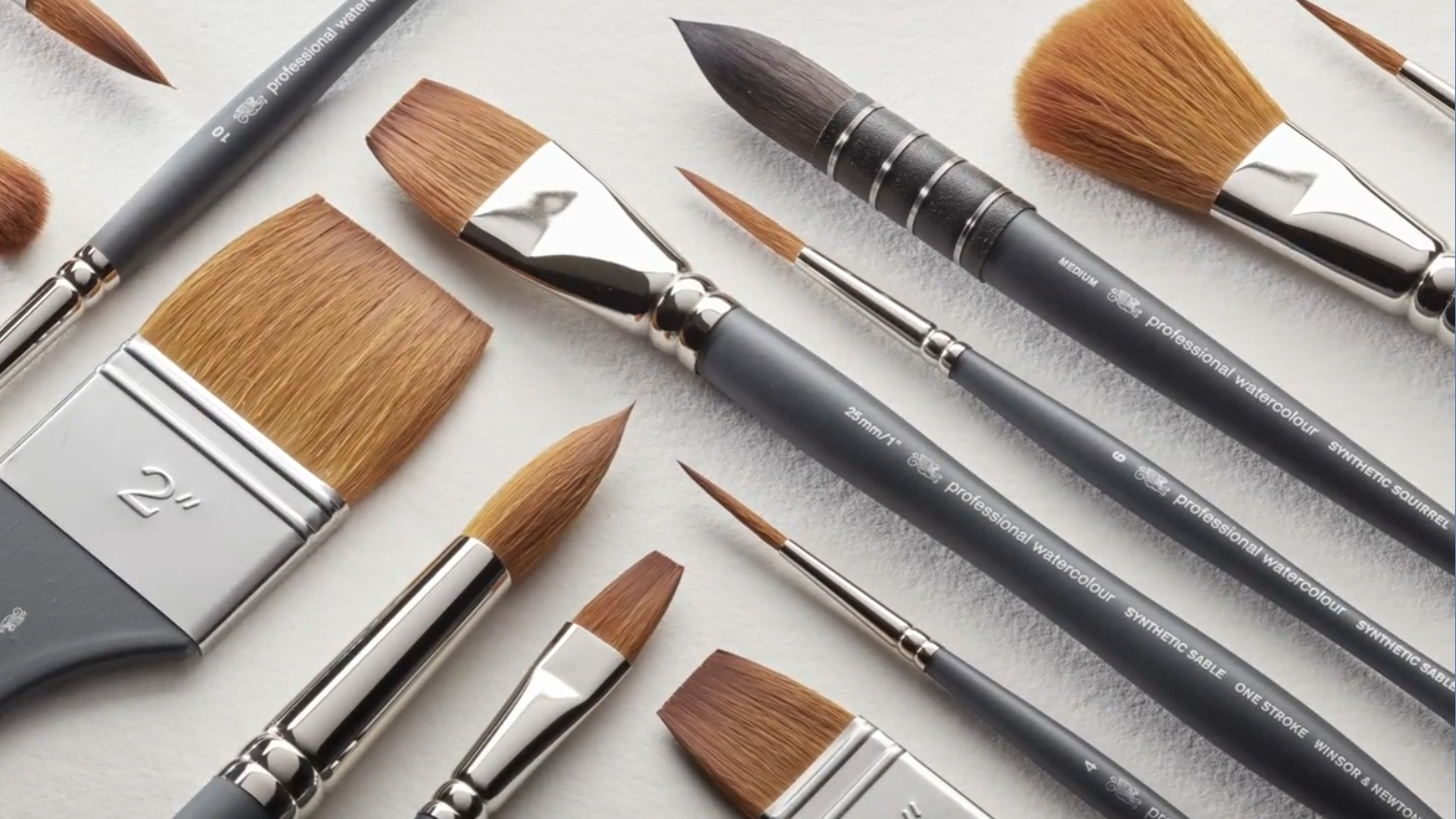
The truth is, these mass-produced sets, which you’ll find overflowing in art stores and online marketplaces, often have serious quality issues. They may rust quickly, lose bristles within the first month, or feature handles that come loose.
To steer clear of these pitfalls, focus on brands known for quality. You’ll find that you don’t need a “complete” set right off the bat. Start building your collection slowly; smaller packs of 3 to 6 high-quality brushes usually offer the best value for your money.
Bristle Material
When it comes to bristle material, you’ll find options ranging from synthetic fibers to natural hairs like squirrel and sable. Among these, Kolinsky sable brushes often come with the highest price tag.
While synthetic bristles might seem like the budget-friendly choice for beginners, investing in a quality set from the outset can make all the difference. With proper care, good watercolor brushes can last for decades, making them ultimately more cost-effective than replacing cheaper sets annually. If top-tier brushes are out of your budget, consider opting for a blend or high-quality synthetic brushes, along with a brush soap and a care kit.
Shape and Size
Let’s set the record straight: You don’t need every brush shape and size to excel in watercolor painting. In fact, you’ll do just fine with a well-chosen set of four: a couple of rounds, one flat, and either a large mop or wash brush. You’ll often find that larger mop or wash brushes are not included in sets, so be prepared to purchase this separately.
Price
While it’s tempting to go for the cheapest option, remember that you often get what you pay for, high-quality brushes not only perform better but can last for years, making them a more cost-effective choice in the long run. If you’re just starting out, consider mid-range brushes that offer a good balance between quality and price, however keep an eye open for sales and value packs from high-quality brands, so keep an eye out for those golden opportunities.
The 5 Best Watercolor Brushes for Beginners in 2023
- Best Overall Watercolor Brushes for Beginners — Princeton Velvetouch, Mixed-Media Brushes
- Best watercolor brushes for Students — Winsor & Newton Cotman Short Handle Set
- Best Synthetic watercolor brushes for beginners — Princeton Select Artist, Series 3750
- Best watercolor brushes for Detailing — Da Vinci CosmoTop Spin Brush Set
- Best Budget watercolor brushes for beginners — Nicpro Professional Watercolor Brushes
#1. Best Overall Watercolor Brushes for Beginners — Princeton Velvetouch, Mixed-Media Brushes.
Selection Criteria
- Presentation: Set of 4 pcs.
- Our Score: 9/10
- Material: FSC Wood Handless, Synthetic Hair.
- Our Score: 9/10
- Type: Round 4(1), Long Round 8(1), Angle shader 3/8(1), Wash 3/4(1).
- Our Score: 8/10
- Price: $23.00.
- Our Score: 7/10
About the Princeton Velvetouch, Mixed-Media Brushes.
A versatile powerhouse in the world of mixed-media brushes, the Princeton Velvetouch series is a hit among artists dabbling in various mediums, from acrylic and oil to watercolor. Artists often comment on how the synthetic blend bristles perform strikingly similar to natural hairs, especially in how they hold and distribute the pigment. The brush’s resilience is consistently mentioned by professional artists praising its ability to maintain shape after multiple uses. The Velvetouch collection has it all, a fine point for detail work and a robust structure that can handle heavier paints.
Pros
- Versatile use
- Beginner-friendly
- Durable bristles
Cons
- Slightly expensive
- Limited shapes
- Mixed feedback
2. Best Watercolor Brushes for Students — Winsor & Newton Cotman Short Handle Set
Selection Criteria
- Presentation: Set of 7 pcs.
- Our Score: 8/10
- Material: Wood Handless, synthetic fibers of differing thicknesses.
- Our Score: 7/10
- Type: Round 1 & 6, Rigger 2(1), Filbert 1/4″(1), One Stroke 3/8″(1), Angled 1/8″(1), Fan 2(1).
- Our Score: 9/10
- Price: $32.55.
- Our Score: 9/10
About the Winsor & Newton Cotman Short Handle Set.
Winsor & Newton’s Cotman Short Handle Set has constantly received high praise for its performance, particularly among intermediate-level artists. The synthetic bristles are often cited for their capability to hold a decent amount of water and pigment, making the brushes versatile for both washes and fine details. Artists appreciate the set’s durability and how the brushes maintain their shape over time. The short handles are celebrated for providing exceptional control, especially when working on smaller canvases or intricate details making the set a reliable, cost-effective alternative for beginners.
Pros
- Affordable price
- Student-focused
- Good variety
Cons
- Less durable
- Synthetic bristles
- Limited finesse
3. Best Synthetic Watercolor Brushes for Beginners — Princeton Select Artist, Series 3750.
Selection Criteria
- Presentation: Set of 6 pcs.
- Our Score: 8/10
- Material: Plastic Handless, Synthetic and natural hair.
- Our Score: 7/10
- Type: Round 4(1), Oval Mop 3/4(1), Angle Shader 3/8(1), Flat Shader 6(1), Filbert 4(1), Liner1(1).
- Our Score: 8/10
- Price: $13.42.
- Our Score: 8/10
About the Princeton Select Artist, Series 3750.
With the Series 3750, Princeton offers a multipurpose tool that excels in versatility. Artists who have tried these brushes often highlight the durability of the synthetic bristles, which maintain their shape even after repeated use across different mediums. The range of shapes available is often touted as one of the set’s most beneficial features, enabling artists to expand their technique repertoire without switching brush brands, keeping an amazing performance but at a more accessible price point.
Pros
- Synthetic quality
- Inexpensive
- Easy maintenance
Cons
- Lacks versatility
- Limited lifespan
- Basic performance
4. Best Watercolor Brushes for Detailing — Da Vinci CosmoTop Spin Brush Set
Selection Criteria
- Presentation: Set of 4 pcs.
- Our Score: 8/10
- Material: Wood Handless, Synthetic Fibers..
- Our Score: 9/10
- Type: Round 0, 6 & 8, Wash 10(1).
- Our Score: 9/10
- Price: $38.95.
- Our Score: 7/10
About the Da Vinci CosmoTop Spin Brush Set.
Known for its artisan quality, the Da Vinci brushes are highly recommended by those who take their watercolor art seriously. Their synthetic blend is so good that many consider it rivals the most expensive natural hair brushes. Their durability is another frequently mentioned advantage, with reports of the brushes maintaining their performance over years and years. Artists particularly their ability to create washes and gradient effects. On the downside, the set is on the pricier side making it a not-so-accessible beginner alternative, however, it can be considered a worthwhile investment for those aiming for professional-level work.
Pros
- Fine detailing
- High quality
- Natural bristles
Cons
- Expensive
- Specialized use
- Maintenance required
5. Best Budget Watercolor Wrushes for Beginners — Nicpro Professional Watercolor Brushes
Selection Criteria
- Presentation: Set of 15 pcs.
- Our Score: 9/10
- Material: Wood Handless, Synthetic Squirrel Hair..
- Our Score: 8/10
- Type: Round 1,2,3,4,5,6,7,8,9,10, Liner 3/0(1). Flat 1/2(1) ,Flat 1(1), Oval wash 3/4(1).
- Our Score: 8/10
- Price: $19.99.
- Our Score: 9/10
About the Nicpro Professional Watercolor Brushes
Nicpro’s Professional Watercolor Brushes are often described as the ‘sleeper hit’ in the world of art supplies. Artists ranging from beginners to professionals have lauded the quality of the synthetic bristles, emphasizing their ability to mimic the performance of natural hairs in both paint-holding and -distributing capabilities. The set is commonly described as delivering “more bang for your buck,” offering an excellent balance of quality and affordability making it a fantastic backup set for professionals or a primary set for those still exploring their style.
Pros
- Budget-friendly
- Beginner-suited
- Decent quality
Cons
- Short lifespan
- Limited variety
- Inconsistent bristles




